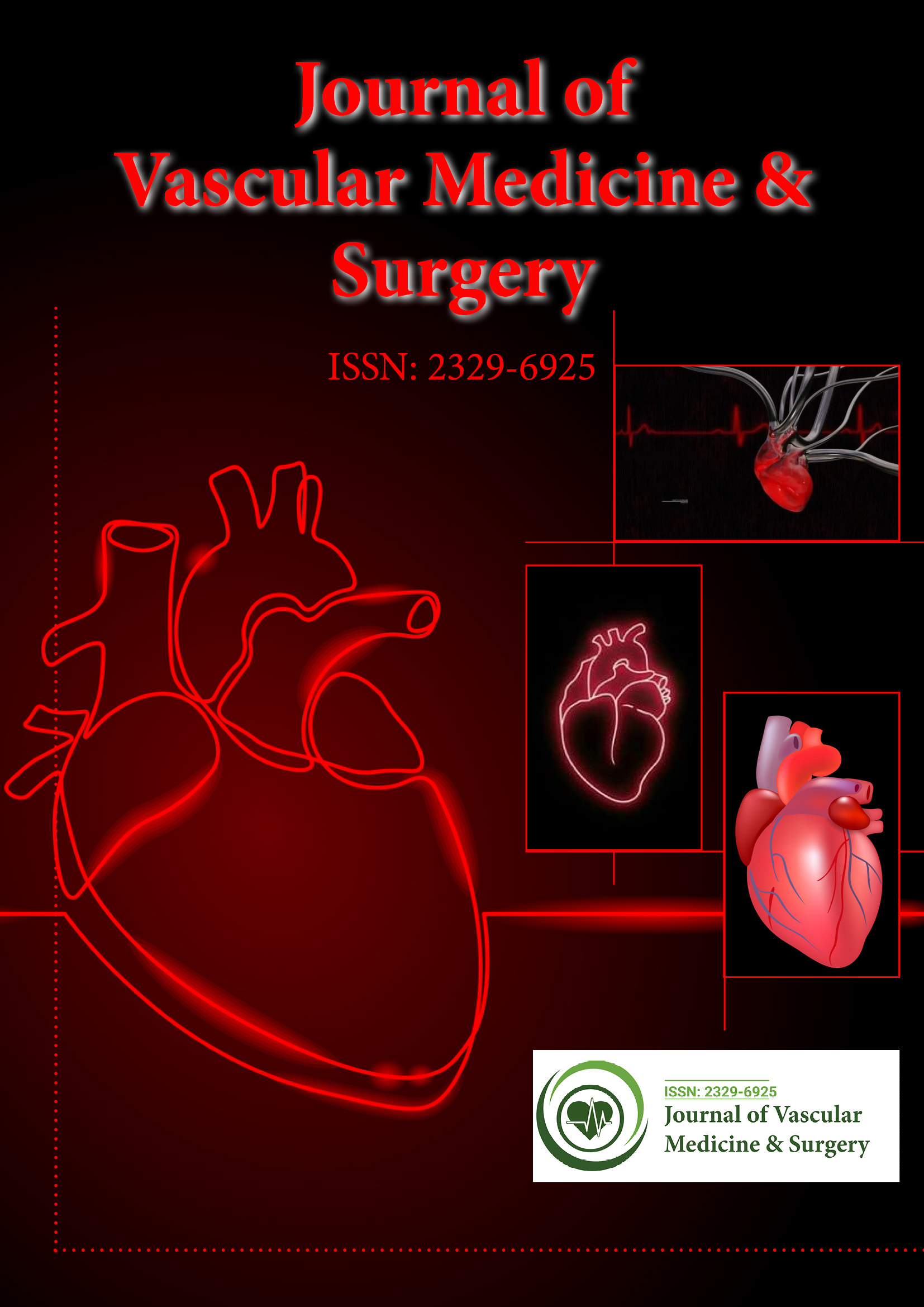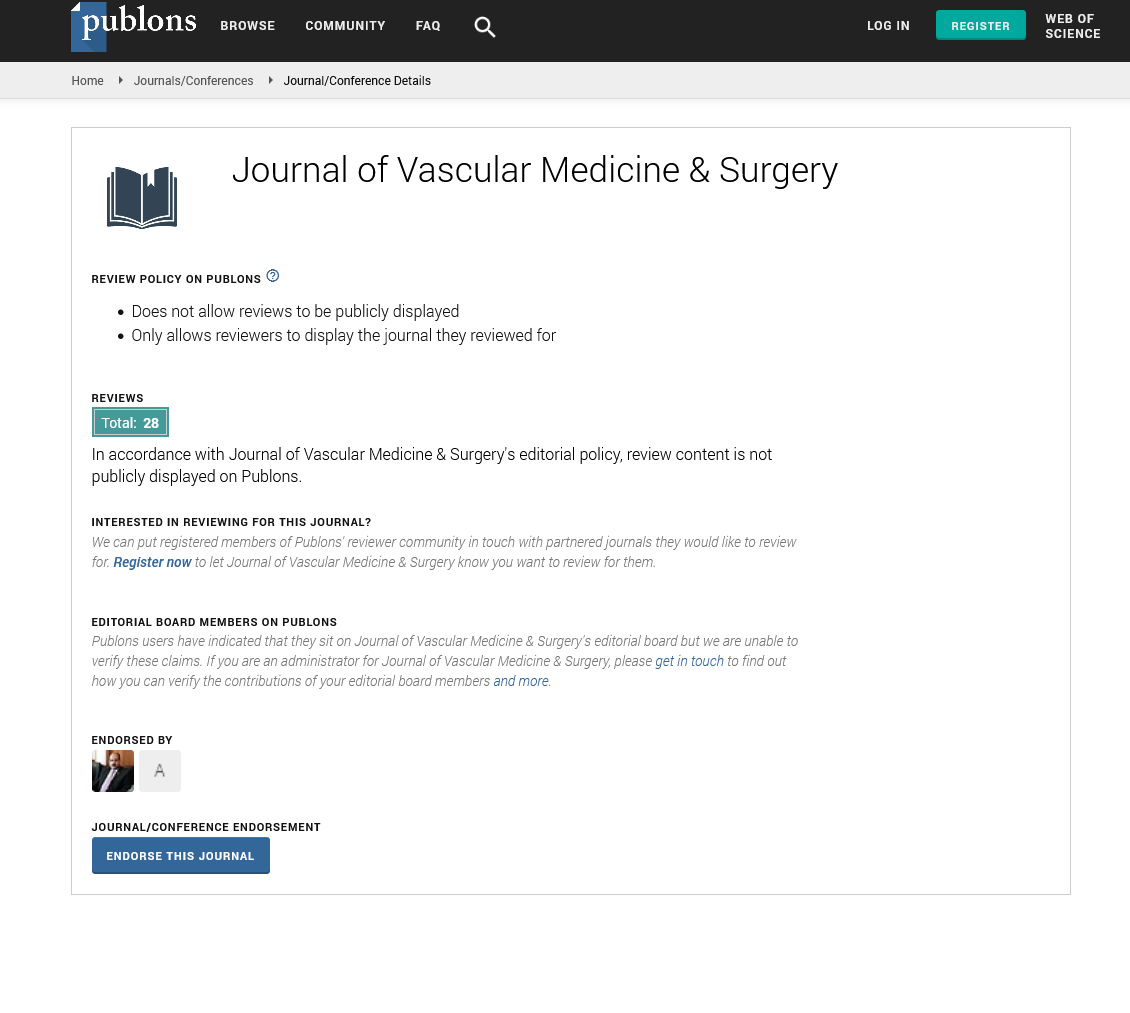Indexed In
- Open J Gate
- Academic Keys
- RefSeek
- Hamdard University
- EBSCO A-Z
- OCLC- WorldCat
- Publons
- Euro Pub
- Google Scholar
- SHERPA ROMEO
Useful Links
Share This Page
Journal Flyer

Open Access Journals
- Agri and Aquaculture
- Biochemistry
- Bioinformatics & Systems Biology
- Business & Management
- Chemistry
- Clinical Sciences
- Engineering
- Food & Nutrition
- General Science
- Genetics & Molecular Biology
- Immunology & Microbiology
- Medical Sciences
- Neuroscience & Psychology
- Nursing & Health Care
- Pharmaceutical Sciences
Perspective - (2025) Volume 13, Issue 3
The Evolution of Vascular Surgery Training: Adapting to Technological Innovation While Preserving Core Surgical Skills
Guillaume Goudot*Received: 28-Feb-2025, Manuscript No. JVMS-25-28763; Editor assigned: 03-Mar-2025, Pre QC No. JVMS-25-28763 (PQ); Reviewed: 17-Mar-2025, QC No. JVMS-25-28763; Revised: 24-Mar-2025, Manuscript No. JVMS-25-28763 (R); Published: 31-Mar-2025, DOI: 10.35248/2329-6925.25.13.590
Description
The training of vascular surgeons has undergone profound transformation over the past two decades, reflecting broader changes in the specialty itself. As vascular surgery has evolved from a primarily open surgical discipline to one encompassing a diverse array of endovascular, hybrid, and traditional approaches, training paradigms have struggled to adapt. This evolution presents both opportunities and challenges, requiring thoughtful reconsideration of educational models, technical skill acquisition, and the fundamental identity of vascular surgeons. This commentary examines the current state of vascular surgery training, emerging challenges, and potential pathways forward.
The traditional training model—five years of general surgery followed by one to two years of vascular fellowship—has largely given way to integrated vascular residency programs offering focused training over five to seven years following medical school. This shift recognized both the expanding scope of vascular interventions and the diminishing relevance of certain general surgical experiences to contemporary vascular practice. Integrated programs now account for approximately half of all vascular training positions in the United States, with continued growth anticipated. Early outcomes from these programs suggest comparable or superior technical competency despite reduced overall training duration, likely reflecting the greater focus on vascular-specific experience throughout the training continuum.
The most significant challenge facing contemporary vascular training is the expanding technical scope of the specialty. Trainees must now master traditional open surgical techniques, endovascular interventions across multiple vascular beds, noninvasive vascular laboratory interpretation, and increasingly complex pre-procedural planning. Each of these domains requires substantial experience for competence, yet training duration remains relatively fixed. The ACGME case log requirements reflect this breadth, specifying minimum numbers across numerous procedural categories from carotid endarterectomy to tibial intervention to dialysis access creation.
Several factors further complicate this technical training challenge. First, as endovascular approaches have become first-line therapy for many conditions, opportunities for open surgical experience have diminished substantially. Many trainees now complete residency having performed fewer than 20 aortic reconstructions—a procedure once considered a cornerstone of vascular surgical identity. Second, the increasing complexity of endovascular devices, particularly for aortic pathology, requires focused training and experience for safe utilization. Fenestrated and branched endografts, intravascular lithotripsy, and specialized atherectomy systems each have unique learning curves and technical considerations. Third, the growing emphasis on outpatient and office-based procedures shifts training opportunities away from traditional hospital settings, requiring new educational models.
The response to these challenges has included several educational innovations. Simulation has emerged as a critical adjunct to clinical experience, allowing repetitive practice of technical skills in a consequence-free environment. High-fidelity simulators now exist for most common vascular procedures, from carotid stenting to complex endovascular aneurysm repair. Several studies have demonstrated skill transfer from simulation to clinical performance, with potential benefits for both patient safety and trainee confidence. The Fundamentals of Endovascular Surgery curriculum represents an important step toward standardizing simulation-based training across programs.
Technical skill acquisition models have evolved from the traditional apprenticeship approach to more structured frameworks. The Dreyfus model of skill acquisition-progressing from novice to advanced beginner, competent, proficient, and eventually expert-provides a useful conceptual framework for staged responsibility. Entrustable Professional Activities (EPAs) extend this concept by defining specific clinical tasks that trainees can be entrusted to perform without supervision once sufficient competence is demonstrated. This competency-based approach may eventually allow more individualized training pathways based on demonstrated proficiency rather than rigid time requirements.
Conclusion
The integration of formal quality improvement and patient safety training represents another important evolution. Vascular surgery has long emphasized outcomes assessment through initiatives like the Vascular Quality Initiative, but systematic training in quality improvement methodology, error analysis, and systems thinking remains inconsistent across programs. As healthcare systems increasingly emphasize value and quality metrics, these skills become essential components of surgical practice and worthy of dedicated curricular attention. Leadership development similarly requires greater emphasis in contemporary training. As vascular surgeons increasingly lead multidisciplinary teams, direct service lines, and participate in hospital administration, skills including conflict resolution, change management, financial literacy, and team building become critically important. Formal leadership curricula remain relatively rare in vascular training but represent an important opportunity to prepare trainees for the non-technical aspects of their future roles. Vascular surgery training continues to evolve in response to the specialty's expanding scope and technological advancement. The ideal training paradigm remains elusive, but likely involves balanced exposure to open and endovascular techniques, structured technical skill acquisition, progression toward competency-based assessment, and focused development of non-technical skills.
Citation: Goudot G (2025). The Evolution of Vascular Surgery Training: Adapting to Technological Innovation While Preserving Core Surgical Skills. J Vasc Surg. 13:589.
Copyright: © 2025 Goudot G. This is an open access article distributed under the terms of the Creative Commons Attribution License, which permits unrestricted use, distribution, and reproduction in any medium, provided the original author and source are credited.

